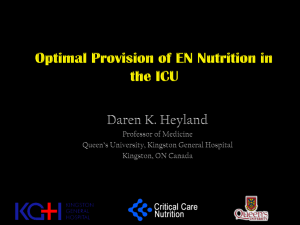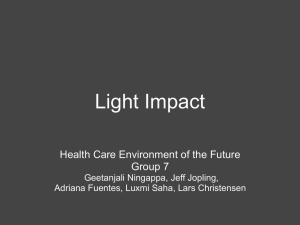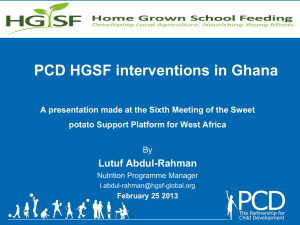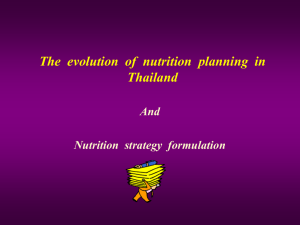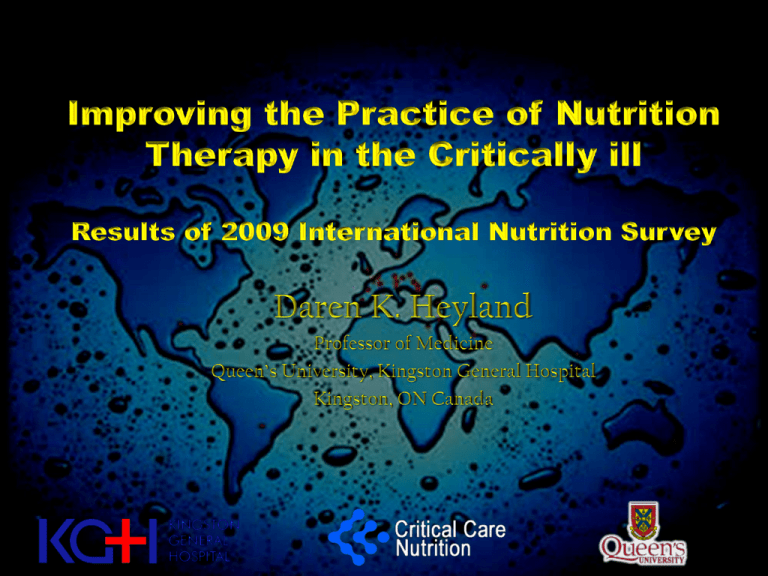
Learning Objectives
• Convince you that efforts to improve nutrition in the ICU
are worthwhile
• Familiarize you with the recommendations of the Canadian
Critical Care Nutrition Clinical Practice Guidelines
• Make you aware of current nutrition practices in ICUs in
your own geographic region and throughout the world
• Enable you to identify gaps between guideline
recommendations and current practices in ICUs
• Provide tools to begin to narrow that GAP!
EN Intake
kcal
Underlying Pathophysiology Of Critical Illness
Prescribed Engergy
2000
1800
1600
1400
1200
1000
800
600
400
200
0
Energy Received From Enteral Feed
Caloric Debt
1
3
5
7
9
11
13
15
17
19
21
Days
Caloric debt associated with:
Longer ICU stay
Days on mechanical ventilation
Complications
Mortality
Rubinson CCM 2004; Villet Clin Nutr 2005; Dvir Clin Nutr 2006; Petros Clin Nutr 2006
• Point prevalence survey of nutrition
practices in ICU’s around the world
conducted Jan. 27, 2007
• Enrolled 2772 patients from 158 ICU’s over
5 continents
• Included ventilated adult patients who
remained in ICU >72 hours
Hypothesis
• There is a relationship between amount of
energy and protein received and clinical
outcomes (mortality and # of days on
ventilator)
• The relationship is influenced by nutritional
risk
• BMI is used to define chronic nutritional risk
What Study Patients Actually Rec’d
• Average Calories in all groups:
– 1034 kcals and 47 gm of protein
Result:
• Average caloric deficit in Lean Pts:
– 7500kcal/10days
• Average caloric deficit in Severely Obese:
– 12000kcal/10days
Relationship Between Increased Calories
and 60 day Mortality
BMI Group
P-value
Odds
95%
Ratio Confidence
Limits
Overall
0.76
0.61
0.95
0.014
<20
0.52
0.29
0.95
0.033
20-<25
0.62
0.44
0.88
0.007
25-<30
1.05
0.75
1.49
0.768
30-<35
1.04
0.64
1.68
0.889
35-<40
0.36
0.16
0.80
0.012
>=40
0.63
0.32
1.24
0.180
Legend: Odds of 60-day Mortality per 1000 kcals received per day adjusting for nutrition
days, BMI, age, admission category, admission diagnosis and APACHE II score.
Relationship of Caloric Intake, 60 day Mortality and BMI
60
BMI
All Patients
< 20
20-25
25-30
30-35
35-40
>40
Mortality (%)
50
40
30
20
10
0
0
500
1000
1500
Calories Delivered
2000
Relationship Between Increased Energy and
Ventilator-Free days
Adjusted
95% CI
BMI Group
P-value
Estimate
LCL
UCL
Overall
3.5
1.2
5.9
0.003
<20
2.8
-2.9
8.5
0.337
20-<25
4.7
1.5
7.8
0.004
25-<30
0.1
-3.0
3.2
0.958
30-<35
-1.5
-5.8
2.9
0.508
35-<40
8.7
2.0
15.3
0.011
>=40
6.4
-0.1
12.8
0.053
Legend: # of VFD per 1000 kcals received per day adjusting for nutrition days, BMI, age,
admission category, admission diagnosis and APACHE II score.
Effect of Increasing Amounts of Calories
from EN on Infectious Complications
Multicenter observational study of 207 patients >72 hrs in ICU followed
prospectively for development of infection
for increase of 1000 cal/day, OR of infection at 28 days
Heyland Clinical Nutrition 2010
Effect of Increasing Amounts of Protein
from EN on Infectious Complications
Multicenter observational study of 207 patients >72 hrs in ICU followed
prospectively for development of infection
for increase of 30 gram/day, OR of infection at 28 days
Heyland Clinical Nutrition 2010
Relationship between increased nutrition intake and
physical function (as defined by SF-36 scores)
following critical illness
Multicenter RCT of glutamine and antioxidants (REDOXS Study)
First 364 patients with SF 36 at 3 months and/or 6 months
Model *
Estimate (CI)
P values
PHYSICAL FUNCTIONING (PF) at 3 months
3.2 (-1.0, 7.3)
P=0.14
ROLE PHYSICAL (RP) at 3 months
4.2 (-0.0, 8.5)
P=0.05
(A) Increased energy intake
for
STANDARDIZED PHYSICAL COMPONENT
1.8 (0.3, 3.4)
SCALE (PCS) at 3 months
P=0.02
PHYSICAL FUNCTIONING (PF) at 6 months
0.8 (-3.6, 5.1)
P=0.73
ROLE PHYSICAL (RP) at 6 months
2.0 (-2.5, 6.5)
P=0.38
STANDARDIZED PHYSICAL COMPONENT
0.70 (-1.0, 2.4)
P=0.41
SCALE (PCS)
at 6gram/day,
months
increase
of 30
OR of infection at 28 days
Heyland Unpublished Data
Mechancially Vent’d patients >7days
(average ICU LOS 28 days)
Faisy BJN 2009;101:1079
Permissive Underfeeding
(Starvation)?
187 critically ill patients
Tertiles according to ACCP recommended levels of
caloric intake
Highest tertile (>66% recommended calories) vs.
Lowest tertile (<33% recommended calories)
in hospital mortality
Discharge from ICU breathing spontaneously
Middle tertile (33-65% recommended calories) vs.
lowest tertile
Discharge from ICU breathing spontaneously
Krishnan et al Chest 2003
Optimal Amount of Calories for
Critically Ill Patients:
Depends on how you slice the cake!
• Objective: To examine the relationship between the
amount of calories administered and mortality using
various sample restriction and statistical adjustment
techniques and demonstrate the influence of the analytic
approach on the results.
• Design: Prospective, multi-institutional audit
• Setting: 352 Intensive Care Units (ICUs) from 33
countries.
• Patients: 7,872 mechanically ventilated, critically ill
patients who remained in ICU for at least 96 hours.
Heyland Crit Care Med 2011 (in press)
Optimal Amount of Calories for
Critically Ill Patients:
Depends on how you slice the cake!
• Sample restriction approaches have included limiting
analyzed patients to those:
1.
2.
3.
•
In the ICU for at least 96 hours,
In the ICU at least 96 hours prior to progression to exclusive oral feeding and
Eliminating days after progression to exclusive oral feeding from the calculation
of nutrition intake.
Statistical adjustment approaches have included using
regression techniques to adjust for:
1.
2.
3.
ICU length of stay (LOS),
Evaluable nutrition days and
Relevant baseline patient characteristics or some combination thereof.
Heyland Crit Care Med 2011 (in press)
Association between 12 day average caloric adequacy and
60 day hospital mortality
A. In ICU for at least 96 hours. Days after
permanent progression to exclusive oral
feeding are included as zero calories*
B. In ICU for at least 96 hours. Days after
permanent progression to exclusive oral
feeding are excluded from average
adequacy calculation.*
Unadjusted
Adjusted
C. In ICU for at least 4 days before permanent
progression to exclusive oral feeding. Days after
permanent progression to exclusive oral feeding
are excluded from average adequacy
calculation.*
>2/3 Unadjusted
>2/3 Adjusted
1/3-2/3 Unadjusted
1/3-2/3 Adjusted
D. In ICU at least 12 days prior to permanent
progression to exclusive oral feeding*
0.4
0.6
0.8
1.0
1.2
1.4
1.6
Odds ratios with 95% confidence intervals
Adjusted for evaluable days and covariates,covariates include region (Canada, Australia and New Zealand, USA, Europe and South Africa,
Latin America, Asia), admission category (medical, surgical), APACHE II score, age, gender and BMI.
Association Between 12-day Caloric
Adequacy and 60-Day Hospital Mortality
Quality
Improvement
Target
More is Better!
If you feed them (better!)
They will leave (sooner!)
ICU patients are not all created equal…should
we expect the impact of nutrition therapy to be
the same across all patients?
Trophic vs. Full enteral feeding in critically ill
patients with acute respiratory failure
• Single center study of 200 mechanically ventilated patients
• Trophic feeds: 10 ml/hr x 5 days
Rice CCM 2011;39:967
Trophic vs. Full enteral feeding in critically ill
patients with acute respiratory failure
No difference between groups!
Didn’t measure infection nor physical function
Rice CCM 2011;39:967
Trophic vs. Full enteral feeding in critically ill
patients with acute respiratory failure
•
•
•
•
•
Average age 51
Few comorbidities
Average BMI 29
All fed within 24 hrs (benefits of early EN)
Average duration of study intervention 5 days
No effect in young, healthy, overweight
patients who have short stays!
Large multicenter trial of this concept
(EDEN study) by ARDSNET just finished
ICU patients are not all created equal…should
we expect the impact of nutrition therapy to be
the same across all patients?
RCT Level of Evidence that
More EN= Improved Outcomes
RCTs of aggressive feeding protocols
Results in better protein-energy intake
Associated with reduced complications and improved
survival
Taylor et al Crit Care Med 1999; Martin CMAJ 2004
Meta-analysis of Early vs Delayed EN
Reduced infections: RR 0.76 (.59,0.98),p=0.04
Reduced Mortality: RR 0.68 (0.46, 1.01) p=0.06
www.criticalcarenutrition.com
More (and Earlier) is Better!
If you feed them (better!)
They will leave (sooner!)
Objectives of International Survey
Quality Improvement
• To determine current nutrition practice in the adult critical
care setting (overall and subgroups)
• Illuminate gaps between best practice and current practice
• To identify nutrition practices to target for quality
improvement initiatives
Generate New Knowledge
• To determine factors associated with optimal provision of
nutrition
• To determine what nutrition practices are associated with
best clinical outcomes
History of International Surveys
• 3 previous surveys in Canada
– 2001, 2003, 2004
– N > 50
• Extended to other countries
– Focus on North America in 2007 (n=167)
– Focus on Australasia in 2008 (n=169)
– Focus back on North America in 2009 (n=172)
• 2011, Focus on Latin America
Methods
Eligibility Criteria
• ICU Site
– >8 beds
– Availability of individual with knowledge of clinical
nutrition to collect data
• Patient
– In ICU > 72 hours
– Mechanically ventilated within 48 hours
Methods
• Prospective observational cohort study
• Start date: 16th September 2009
• Aim 20 consecutive patients
– Min 8 pts
• Data included:
– Hospital and ICU demographics
– Patient baseline information (e.g. age, admission diagnosis, APACHE
II)
– Baseline Nutrition Assessment
– 12 days Daily Nutrition data (e.g. type of NS, amount NS received)
– 60 day hospital outcomes (e.g. mortality, length of stay)
Web based Data Capture System
Benchmarking
Individual ICUs compared to:
•Canadian Clinical Practice Guidelines
•All ICUs
•ICUs from same geographic region
Early vs Delayed Nutrition Intake
• Recommendations: Based on 8 level 2 studies, we recommend early
enteral nutrition (within 24-48 hrs following resuscitation) in critically ill
patients.
Time to Initiation of EN (hrs)
120
100
80
Site
Maximum
Minimum
Median
60
40
20
0
Your site
All sites
Sister sites
Who participated in 2009? :
157 ICUs
Canada: 32
Europe: 14
USA: 63
Mexico: 2
Brazil:1
Colombia:5
Peru:1
Venezuela:1
Latin
America: 10
Italy: 2
UK: 7
Ireland: 2
Norway: 1
Switzerland: 1
Czech Republic: 1
Asia: 16
China: 1
Taiwan: 1
India: 10
Iran : 1
Japan: 1
Singapore: 2
Australia &
New Zealand:
22
ICU Characteristics
Characteristics
Total (n=157)
Hospital Type
Teaching
Non-teaching
Size of Hospital (beds)
Mean (Range)
ICU Structure
Open
Closed
Other
Size of ICU (beds)
Mean (Range)
Designated Medical Director
Presence of Dietitian(s)
FTE Dietitians (per 10 beds)
Mean (Range)
116 (73.9%)
41 (26.1%)
503 (50, 1500)
49 (31.2%)
104 (66.2%)
4 (2.6%)
19 (6, 64)
149 (94.9%)
145 (92.4%)
0.4 (0.0, 1.7)
Patient Characteristics
Characteristics
Total
n=3028
Age (years)
Median [Q1,Q3]
61 [48, 73]
Sex
Female
Male
1215 (40.1%)
1813 (59.9%)
Medical
Surgical: Elective
Surgical: Emergency
1952 (64.5%)
366 (12.1%)
710 (23.4%)
Admission Category
BMI (kg|m2)
Median [Q1, Q3]
26.0 [22.8, 30.8]
Median [Q1, Q3]
22 [17, 28]
Apache II Score
Presence of ARDS
Yes
413 (13.6%)
Outcomes at 60 days
Characteristics
Length of Mechanical Ventilation (days)
Median [Q1, Q3]
Length of ICU Stay (days)
Median [Q1, Q3]
Length of Hospital Stay (days)
Median [Q1,Q3]
Patient Died (within 60 days)
Yes
Total
n=2948
7.2 [3.3, 15.2]
10.3 [5.9, 19.8]
18.9[10.4, 36.7]
738(24.7%)
We strongly recommend the use
of enteral nutrition over
parenteral nutrition
Type of Artificial Nutrition
PN Only
6%
EN+PN
13%
EN Only
71%
None
10%
n=3028 patients
Use of EN Only
100
73.6%
93.9%
90
80
% ICU days
70
62.2%
66.7%
60
50
40
30
20
9.8%
10
0
Canada
n=17567 patients days
Australia and
New Zealand
USA
Europe
Latin America
Asia
Total
Use of PN Only
50
45
40
38.6%
% ICU days
35
30
25
20
15
10.0%
10
8.7%
6.6%
5
0.6%
0
Canada
n=2294 patients days
Australia and
New Zealand
USA
Europe
Latin America
Asia
Total
Role of Supplemental PN
We recommend that parenteral nutrition not be started at the same time as
enteral nutrition.
In the patient who is not tolerating adequate enteral nutrition, there are insufficient
data to put forward a recommendation about when parenteral nutrition should be
initiated.
Practitioners will have to weigh the safety and benefits of initiating PN in patients
not tolerating EN on an individual case-by-case basis.
We recommend that PN not be started in critically ill patients until all strategies to
maximize EN delivery (such as small bowel feeding tubes, motility agents) have
been attempted.
Use of EN + PN
80
72.2%
70
% ICU days
60
50
40
30
20
10
11.7%
4.4%
2.7%
0.3%
0
Canada
n=1157 patients days
Australia and
New Zealand
USA
Europe
Latin America
Asia
Total
EN in Combination with PN
% of patients received motility agents before PN started
% received motility agents before PN started
100
90
80
70
63.2
60
50
34.6
40
30
21.4
20
10
0
Canada
Australia and
New Zealand
USA
Europe
Latin America
Asia
Total
We recommend early enteral
nutrition (within 24-48 hrs
following admission) in critically
ill patients
Timing of Initiation of EN
168
Time to Initiation of EN (hours)
144hrs
144
120
96
72
50hrs
48
41hrs
30hrs
24
9hrs
0
Canada
Australia and
New
Zealand
USA
Europe
Latin
America
Asia
Total
An evidence based feeding
protocol should be considered as
a strategy to optimize delivery of
enteral nutrition
Use of a Feeding Protocol
Characteristics
Total
n=157
Feeding Protocol
Yes
Gastric Residual VolumeThreshold
Mean (range)
Algorithms included in Protocol
Motility agents
Small bowel feeding
Withholding for procedures
HOB Elevation
Other
129 (82.2%)
240 (50, 500)
90 (72.6%)
69 (55.6%)
69 (55.6%)
117 (94.4%)
19 (15.3%)
In critically ill patients who
experience feed intolerance (high
gastric residual volumes, emesis)
the use of a motility agent and
small bowel feeding tubes are
recommended
Strategies to Optimize EN Delivery:
Motility Agents
100.0
100
90
86%
% patients with HGRV
80
67%
70
60
46%
50
40
30
20
10
0.0
0
Canada
Australia and
New Zealand
USA
Europe
Latin America
Asia
Total
Strategies to Optimize EN Delivery:
Small Bowel Feeding
100
100
90
% patients with HGRV
80
70
60
44%
50
40
30
20
12%
10
2%
0
0
Canada
Australia and
New
Zealand
USA
Europe
Latin
America
Asia
Total
Composition of EN and Pharmaconutrient
Supplementation recommendations
Arginine-supplemented formulas
Recommend NOT be used
Glutamine supplementation
Enteral should be considered in
burn and trauma
Parenteral strongly
recommended in PN pts
Fish oil enriched formula
Recommended in ARDS
Combined vitamins and trace
elements
Should be considered
Polymeric
Recommend
Use of EN Formula and
Pharmaconutrients
Arginine-supplemented formulas
8.2%(0.0%-94.7%)
Glutamine supplementation (All)
5.9%(0.0%-95%)
Fish oil enriched formula (ARDS)
18.9% (0.0%-100%)
Selenium Supplementation (All)
3.1% (0.0%-100%)
Polymeric
85.9% (0.0%-100.%)
We recommend that
hyperglycemia
(blood sugars >10mmol/l)
be avoided
Blood Glucose >10 mmol/l
40
35
% patient-days
30
25
20
15.2
13.1
15
8.7
10
5
0
Canada
Australia and
New Zealand
USA
Europe
Latin
America
Asia
Total
Overall Performance
Adequacy of Nutrition Support =
Calories received from EN + appropriate PN+Propofol
Calories prescribed
Overall Performance: Kcals
120
87%
% received/prescribed
100
80
58%
60
40
6.8%
20
0
1
2
3
4
5
6
7
8
9
10
11
ICU Day
Mean of All Sites
Best Performing Site
Worst Performing Site
12
Failure Rate
% patients who failed to meet minimal quality targets (80% overall energy adequacy)
% patients not achieve minimum of 80% over stay in ICU
100
89.0
90
80
81.1
83.8
79.4
78.2
83.6
77.8
70
60
50
40
30
20
10
0
Canada
Australia and
New Zealand
USA
Europe
Latin America
Asia
Total
Where can we do better?
• Inadequate EN delivery
– timing of initiation of EN
– feeding protocols
– small bowel feeding and motility agents
• Optimize Pharmaconutrition
– use of glutamine, antioxidants, omega-3 FFA.
• Tighten (not tight) glycemic control
How to Change?
CPGs to bedside
Guidelines
Bedside
Dissemination and
Implementation Strategies
Special JPEN Issue Dedicated to KT
• Knowledge Translation (KT)
– describes the process of moving evidence learned from
clinical research and summarized in CPGs to its
incorporation into clinical and policy decision-making.
– defined as “a dynamic and iterative process that includes
synthesis, dissemination, exchange and ethically-sound
application of knowledge to improve the health of patients,
provide more effective health services and products and
strengthen the health care system.”
– Knowledge transfer, knowledge exchange, research
utilization, implementation science, dissemination, and
diffusion are other terms that have been used
interchangeably to describe the same concept.
Nov 2010, Available online at
www.criticalcarenutrition.com
Understanding Adherence to Guidelines in the ICU:
Development of a Comprehensive Framework
CPG
Characteristics
ADHERENCE
Patient Characteristics
Implementation Process
Provider Intent
Institutional Factors
Provider Characteristics
- Profession
-Critical care expertise
-Educational background
-Personality
Hospital
characteristics
-Structure
- Processes
-Resources
-Patient Case-mix
Knowledge
Attitudes
ICU
characteristics
Familiarity
-Structure
- Processes
-Resources
- Patient Case-mix
-Culture
Awareness
Agreement
Outcome
expectancy
Motivation
Self-efficacy
Jones N, Suurdt J, Ouellette-Kuntz H, Heyland DK
In resuscitated, hemodynamically stable patients, other aspects of patient care take… 50.0
No or not enough feeding pumps on the unit.
48.6
Enteral formula not available on the unit.
46.9
Delays and difficulties in obtaining small bowel access in patients not tolerating… 43.1
No or not enough dietitian coverage during weekends and holidays.
42.4
No feeding tube in place to start feeding.
41.4
Delay in physicians ordering the initiation of EN.
40.7
Non-ICU physicians (i.e. surgeons, gastroenterologists) requesting patients not be… 37.8
Delays in initiating motility agents in patients not tolerating enteral nutrition.
37.2
The current national guidelines for nutrition are not readily accessible.
35.2
Waiting for the dietitian to assess the patient.
34.0
Feeding being held too far in advance of procedures or operating room visits.
31.3
No feeding protocol in place to guide the initiation and progression of enteral… 31.0
Fear of adverse events due to aggressively feeding patients.
29.9
The language of the recommendations of the current national guidelines for… 29.0
Nurses failing to progress feeds as per the feeding protocol.
29.0
Not enough time dedicated to education and training on how to optimally feed… 28.0
Not enough dietitian time dedicated to the ICU during regular weekday hours.
27.8
Not enough nursing staff to deliver adequate nutrition.
23.4
Current feeding protocol is outdated.
23.4
Current scientific evidence supporting some nutrition interventions is inadequate to… 21.3
Lack of agreement among ICU team on the best nutrition plan of care for the patient.
19.3
10.0 15.0 20.0 25.0 30.0 35.0 40.0 45.0 50.0 55.0 60.0 65.0 70.0 75.0 80.0 85.0 90.0
Proportion that responded "important" or "very important"
The Efficacy of Enhanced Protein-Energy Provision via the
Enteral Route in Critically Ill Patients:
The PEP uP Protocol!
•
•
•
•
•
•
Different feeding options based on hemodynamic
stability and suitability for high volume intragastric
feeds.
In select patients, we start the EN immediately at goal
rate, not at 25 ml/hr.
We target a 24 hour volume of EN rather than an hourly
rate and provide the nurse with the latitude to increase
the hourly rate to make up the 24 hour volume.
Start with a semi elemental solution, progress to
polymeric
Tolerate higher GRV threshold (300 ml or more)
Motility agents and protein supplements are started
immediately, rather than started when there is a
problem.
A Major Paradigm Shift in How we Feed Enterally
Heyland Crit Care 2010
Creating a Culture of Clinical
Excellence in Critical Care Nutrition:
The ‘Best of the Best’ Award
Heyland DK, Heyland R, Jones N, Dhaliwal R, Day A
Recognition and Reward
Recognition a
powerful motivator
of human
performance
Determining the Best of the Best
Determinant
Overall Adequacy of EN plus appropriate PN
% patients receiving EN
% of patients with EN initiated within 48 hours
% of patients with high gastric residual volumes
(HGRV) receiving motility agents
% of patients with HGRV receiving small bowel tubes
% of patient glucose measurements greater than 10
mmol/L (excluding day 1; fewest is best)
Rank all eligible ICUs by determinants
Multiply ranking by weighting
ICU with highest score is crowned ‘Best of the Best’
Weighting
10
5
3
1
1
3
Best of the Best Award
• Eligible sites:
Data on 20 critically ill patients
Complete baseline nutrition assessment
Presence of feeding protocol
No missing data or outstanding queries
Permit source verification by CCN
• Awarded to ICU that demonstrate:
Last year, 156 ICUs
participated in an
international audit of
nutrition practices in
critically ill patients. This
year we want to take part.
BEST OF THE BEST
ADD HOSP
LOGO
KGH
2008
Please help us to improve our performance
as it relates to nutrition in our ICU. Better
nutrition therapy translates into reduced
morbidity and improved survival.
Highest ranking nutritional performance
For more information, contact____________________
2009 Best of the Best
Of >200 ICUS competing Internationally
TOP Performers
1. Instituto Neurologico de Antioquia, Medellin, Colombia
1. Royal Prince Alfred Hospital, Sydney, Australia
1. The Alfred, Melbourne, Australia
Determinants to Top Performance
What site and hospital characteristics are associated with top BOB ranking?
(Best Rank=1rst thus a negative number is associated with a better ranking)
Hospital/ICU characteristics**
Ranking
p values
-3.0
0.61
+30.4
0.008
-7.9
0.22
India vs. Canada
+32.7
0.08
Latin America vs. Canada
0.17
0.98
USA vs. Canada
+30.4
<0.0001
-0.24
0.78
-0.89
0.89
-23.5
0.005
Region
Australia and New Zealand vs. Canada
China vs. Canada
Europe and South Africa vs. Canada
Hospital size (per 100 beds)
ICU structure
Closed vs. open or other
Presence of Dietitian(s)
Yes vs. No
Heyland JPEN 2010
International Nutrition Survey 2011
Participate on May 11th 2011
Data on min 20 critically ill patients
Complete baseline nutrition assessment
No missing data or outstanding queries
Permit source verification
Last year, 156 ICUs
participated in an
international audit of
nutrition practices in
critically ill patients. This
year we want to take part.
BEST OF THE BEST
ADD HOSP
LOGO
KGH
2008
Please help us to improve our performance
as it relates to nutrition in our ICU. Better
nutrition therapy translates into reduced
morbidity and improved survival.
Benchmarked Site Report
Compare your performance to other ICUs
Compare your performance to the Canadian CPGs
Highlight gaps in practice and barriers to improving
For more information, contact____________________
International Nutrition Survey 2011
Debriefing session with INS participants
and other interested parties
Today, 5 pm, SOLANA (1rst Floor, South
Tower)
Last year, 156 ICUs
participated in an
international audit of
nutrition practices in
critically ill patients. This
year we want to take part.
BEST OF THE BEST
ADD HOSP
LOGO
KGH
2008
Please help us to improve our performance
as it relates to nutrition in our ICU. Better
nutrition therapy translates into reduced
morbidity and improved survival.
For more information, contact____________________




